
Morna Middleton interviews some top female UK routesetters and gives an insight into the male-dominated world of the routesetting circuit.
Recently, I have been fortunate to have had access to some of the best and most ‘known’ female routesetters in the UK climbing scene. Through a selection of questions, they have been able to share their experiences in what remains a somewhat exclusive area to be able to work, regardless of gender, let alone acquire the recognition needed in order to make a living in doing so. I have chosen to highlight their work for being outstanding setters, but they are also formidable women! Each of them has kindly given candid opinions in good humour, and in response to sometimes potentially controversial questions.
Please could you give a brief introduction to yourself.
My name is Emma Twyford, I have been climbing for 21 years. I have bouldered 7c+, Flashed E7 on trad and headpointed E9. Onsighted 8a on sport and redpointed 8b+/c. My favourite climbing location is anywhere where the sun is shining and the rock is good. I love all things chocolatey!
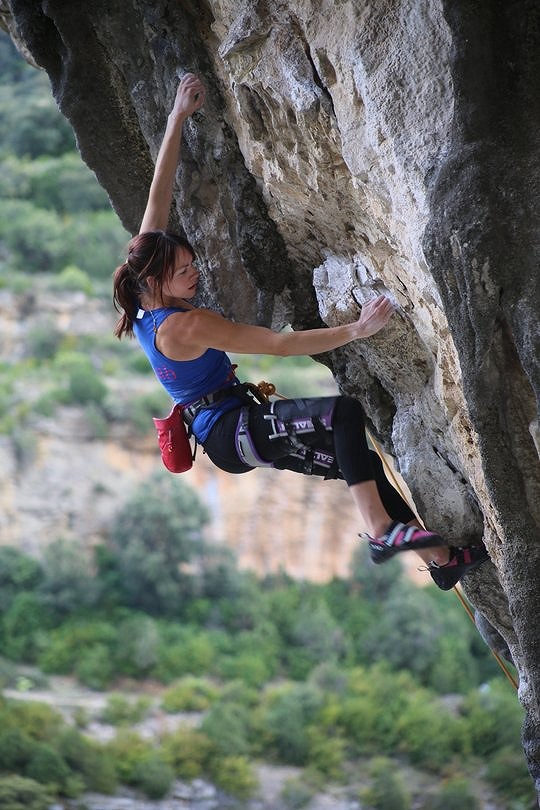
My name is Evie Cotrulia. I’ve been climbing since I was a kid but only got serious about it in my late 20’s. I prefer on-sighting to redpointing. In the UK I like to climb in the Peak. Outside of the UK I like to climb in Switzerland and Spain. I am sponsored by Scarpa UK. I have a 13yr old daughter who has no interest in climbing whatsoever but in one year she can officially belay me and potentially earn a lot of pocket money!
My name is Sandra Berlin. I am the Operations Manager for the new Karma Climbing Centre in Tunbridge Wells, a freelance climbing coach, route setter and mum of a little 4 year old cheeky chap called Louis. I am from Brazil but have been living in the UK since 2002. In 2007 I discovered Rock Climbing and since then it has gradually taken over my life! In 2012, I gave up my position as Marketing and Events Manager for a music festival to dedicate myself to my new career and I haven’t looked back since. I am also an avid yogi (going through Teacher Training at the moment) and lover of good music!
My name is Leah Crane. I’ve been climbing since I was 5 years old starting at a Kids club in Nottingham where I grew up. That’s getting on for 21 years of climbing now, it sounds kind of strange to say it! Through all these years, climbing has shaped my life in places it has taken me, people I’ve met and the highs and lows of the emotional roller-coaster I ride every time I step off the floor. A couple of highlights in my competition climbing has been being Senior British Bouldering Champion two years running and coming 7th in a world cup, narrowly missing the final by one bonus hold. My style of climbing definitely stems from a lot of hard work I put in as a gymnast for 12 years. I wouldn’t be the climber I am today without that sport!
Away from indoor climbing Catalunya is my favourite place to sport climb and generally chill out, it’s the perfect place to unwind and have fun. The Valle Di Mello is also high on my list, the sport climbing and bouldering there is stunning and there is so much of it!
How long have you been setting for, and how/where did your first opportunity to set, arise?
ET: I think I’ve been setting for about 3 or 4 years, my first opportunity was when I asked Rob Napier if I could set for free at the Foundry but learn some of the skills from him before I moved to North Wales. It was a real eye opener and I got thrown in at the deep end setting on the steepest part of the wall. I am grateful I got an opportunity to learn from one of the best route setters at such a good wall.
EC: I have been setting for 5 years. My boyfriend Yann Genoux is a setter and when we met he was head setter at Arch Climbing Wall. I used to go there after work to help him test the new problems he set and one day I finished work early and he wasn’t finished setting. He asked me if I would help him out by setting a couple of problems so I did, with a t-bar! I was too scared to use a drill! I totally loved the creativity of setting. I set for free for a year to build up experience and speed before I charged anyone. The Arch and Boulder Brighton were the first walls to pay for me to set and I will always be grateful to them for taking a chance on me.
SB: My first ever setting experience was in 2012 at High Sports Crawley where I used to be Duty Manager. I remember observing the guys setting and thinking ‘that looks like fun’. I also felt there was a lack of more delicate, subtle problems. They were good technical blocs but all a little too burly and reachy for me! So the lovely Kris Zuray, armed me with a drill and some helpful advice and there I was setting my first few blocs. From then on, I have done some setting at the Reach (where I was fortunate enough to learn from the likes of Gaz Parry, Tricky and SlimFast), Jagg’s School, White Spider and for just over a year I was a head setter at London’s VauxWall. Now, I am looking forward to getting my hands on some shiny new holds for Karma’s beautiful and slick surfaces due to open to the public later this year.
LC: I don’t actually really remember when I ‘started’ setting. From a young age, I would set climbs at the wall in Nottingham with an Allen-key and no ladder, getting pumped silly hanging on one arm whilst trying to get the bolt in the t-nut and the hold the right way up. In later years, I found myself working in London climbing walls, setting boulders and routes and then spread out to walls across the country when I moved back further north to Sheffield, but now only set boulders as the physical side of setting routes and hauling buckets of holds takes too much out of me. I try and train after work and my body feels broken.
I love route setting and then watching people climb them, working out the sequence I had in my head when I put the holds on the wall. It’s safe to say the sequences don’t always match! There is never a wrong or right way of doing something and being 5ft 4” and flexible, I climb very differently to the majority of people.
I think being interested in route setting from such a young age has given me the ability I have to route read. I think like a setter, therefore can usually see how a setter is trying to make you climb.
Which of the following setting opportunities have you participated with?
Boulder setting
Route setting
Competition setting
Paraclimbing route/boulder setting
ET: I have set bouldering, routes and the occasional comp for a wall.
EC: Boulder setting – yes most of the time. Route setting – yes now and again. Competition setting – yes yes yes. I love it. I set comps at White Spider every month and at other walls too. Disability route/boulder setting – no, this has never arisen but I would be keen.
SB: Most of my setting experience has been bouldering. However, I have also enjoyed setting routes at the Reach and Jagg’s. I set the first round of last year’s Lube, alongside Gaz Parry. I’ve also been setting for VauxWall’s ever so popular VauxComp’s FunComp.
LC: Yes, to the first three.
If you were to describe your setting style, how would you describe it?
ET: My style would probably be devious and techy!
EC: I set every style, I’m a professional Ha Ha! Seriously though, because I’m female I think most walls expect my setting to just be crimpy and technical, tick tack tick tack. Women get pigeon holed into that style. I can do crimpy and technical if it’s asked, but I prefer to mix it up with big dynamic/strong moves that I know women as well as men can realistically do, and feel good about themselves.
SB: Hard to describe my own style! I guess it will depend on the mood I’m in. But so far the general feedback has been: Techy and bendy……. I like it!
LC: I definitely like fun and dynamic setting and as I’ve competed for 18 years now, there is also some weirdness in there too. I’m not much of a crimper, so usually you won’t see nasty edges to bare down on, more likely a dyno instead.
I have tackled a bit of setting myself, and encountered a couple of issue’s that I hadn’t considered! For example, I wear contact lenses and found that the dust and ‘bits’ from removing or placing holds caused havoc, particularly if setting in a roof section! I’m not ready for the goggles look, yet! What have you encountered that came as a surprise to you?!
ET: That ladders can be dangerous, it’s funny I get more scared being on a ladder than climbing!
EC: Yeah wood, metal, dust etc is pretty common in the eyes with route setting, contacts or not. I ended up in A&E once because of a wood splinter in my eye. It actually dislodged on the way to the hospital but I thought I’d get my eye checked anyway. They looked at my eyes with their microscope thingy and said both my corneas were scratched to bits. I’m still not ready for the goggles look either though! I had an extremely busy month with setting in December just gone and had cramp in my hand for a couple of hours during setting at Reading from pulling the trigger on the drill. It never happened before or since but that surprised me!
SB: Hmmm…Can’t really think of anything except for the fact that as a left handed person I noticed my left arm getting bigger than the right, as I was using it quite a lot. So I had to learn to hold the drill with either hand, which also makes everything a lot easier when your ladder is on the ‘wrong side’ of the hold.
LC: I believe route setting actually helped me on my way to a shoulder injury. My right shoulder became injured (all fixed now!) and maybe it's coincidental that I’m right handed when using my drill but setting became painful when raising my arm above my head, holding a drill loaded with a hold. I had to stop setting for a while till my shoulder got better and when I came back, I set with my left arm to give my right arm break. Leaning from the ladder to the bolt hole I want with my arm stretched out straight, a large heavy hold on the end is not the best thing for a shoulder joint. Same goes for pushing screws in with your drill to pin holds or apply screw-ons. But I have learnt when I feel tired from setting and need a break and it’s no problem now.
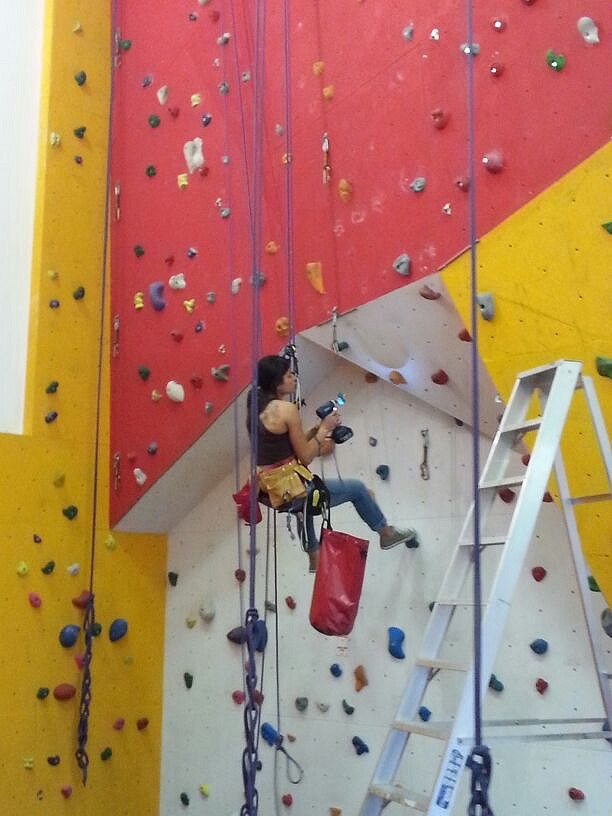
Given the opportunity, what would your dream setting job be?
ET: I’ve set at some pretty cool walls already, but I guess setting for a big comp would be fun and intense at the same time!
EC: I might already have it! I’m the setting manager at White Spider and I also set freelance around the country. Best of both worlds. In terms of a one off particular job, then it would be to set a national competition for women only set by women only.
SB: Setting competitions. Would love to see top level climbers sending (or not) my blocs! Also, I love setting fun circuit style comps, which are accessible to all. It’s great observing people of different ages and abilities enjoying your set. So more of those too!
LC: To set for an all girls comp somewhere. The reason isn't that I want it to be all girls. It's that I understand how girls climb being flexible etc and would love to see my blocs being battled with by a group of girls. And I love setting comp style.
I’ve noticed that there are more females becoming setters, or receiving more attention for doing so. What advice would you give to any woman looking to diversify into setting?
ET: It is hard and physical work so be prepared for it! It’s not for everyone but it can be very rewarding. Don’t be disheartened if it doesn’t go smoothly at first.
EC: Don’t let yourself be intimidated. Be prepared to work for free to build up your confidence, speed, and belief in your own ability. Don’t let yourself be pigeonholed into just setting crimps and technical stuff. Explore the more powerful stuff. Admit when you’ve got something wrong. Learn from everyone you set with.
SB: Go for it! Setting, just as climbing in general, is a very male dominated activity. We must show the boys we can do it, too! But do relax though; don’t go on about it, as if you have something to prove. Don’t be afraid to ask for help and advice. I found that the boys (and any other more experienced setters I have met) were always there to help me when I needed. The climbing world is full of nice people!
LC: Ask your wall to get involved and help out. Be ready to start at the bottom and work your way up, don’t expect to route-set straight away. And that goes for boys and girls. Washing the holds usually comes first, then stripping a wall and helping to test. After that the setting happens when whoever you’re working with thinks you’re ready. It’s hard work, especially in the summer when it’s hot. Running up and down ladders all day, bending picking up holds and screws. Bruises, scrapes and cuts will happen. Oh and then you have to test your creations after and tweak them if they’re wrong. I think most women are put off route setting because they don’t climb ‘hard’. Lower grade problems need setting too and no one knows how women climb better than women.
One thing I will say is that it’s easy for some girls to become intimidated by the route-setting world. A bunch of guys smashing about using power tools. If you’re setting a route and some guy comes over and tries to tell you where to put your holds, stand your ground. Accept what he’s saying but do it your way, even if he’s still standing there watching you. You can tweak when you test if it’s not right. That’s the whole point of you route setting. It’s your route, not his. But also, ask for opinions if you’re in two minds as to what the next move should be, collaborate with the people you’re working with, you’re a team. I LOVE being a part of the route setting world and love everyone I work with, guys and girls.
Should becoming a setter be restricted only to men and women who have competed at a high level, and to a point where they have become ‘known’ within the climbing community?
ET: I don’t think it should and I don’t think that’s the case. I’ve tried to make a reputation for being a good setter, not a good climber.
EC: No, not at all. Become ‘known’ within the climbing community as a setter! If you research most of the IFSC world cup setters then a lot of them have never competed. It hasn’t held them back.
SB: Not at all. I know some amazing climbers who are not particularly great setters! However, I do strongly agree that before you start setting problems you should be an experienced climber. Even if you can’t put all the moves together at the time you are testing, you should at least still be able to test them individually to see if they go! You should have a very good understanding of climbing movement in order to set problems. No matter the grade!
LC: In one word, no. Being a good or high level climber does NOT make you a good setter. Same goes for someone who is good at maths may not be a good teacher. Also being ‘known’ in the climbing world is not enough. You need to be known for your setting. It can be hard to ‘get in’ with head route setters that book the work in but you have to find your way in, maybe volunteering your services at first to get your foot in the door for experience.
Do you think that route setting should require credentials or formal qualifications, or indeed any regulation?
ET: I think a lot of it comes down to common sense rather than formal qualifications. More of it is practice with the kit though some of it does cross over into rope access. I think as climbing walls become more popular formal qualifications will start to kick in.
EC: Well there already are required credentials / qualifications for national and international competition setters, and ABC “guidelines” for route setting practices. But, if you mean for any individual self employed setter at any wall then that’s a tough one. Yes and no.
Yes because perhaps there should be a baseline for safety reasons. I can imagine some people blag their way into setting work and set dangerous routes or routes that just don’t work. They have no clue how to set up their gear etc putting themselves and others at risk. Although maybe because I’m a setting manager and responsible for route safety I’m just more acutely aware of it.
No because it might put off some people from getting into it. Also, just by doing a course to learn the how to work on ropes and how to use a drill doesn’t mean someone can walk into a paid job as a route setter. It takes more than that. I think everyone has one or two good routes / problems in their arsenal but setting up to 20 in a day, several days/week takes a bit more. Maybe some sort of apprenticeship might work better….?
SB: Just like any other occupation which involves risks for setters themselves and others there should be some sort of training and guidelines. People should be made fully aware of the risks that may affect them and/or any other wall user.
LC: This is how it works in the US. The UK so far has managed by teaching its own from the people that already set. I think in the long run, it probably will go to qualifications and credentials for safety reasons. But at the same time I fear if that does happen, route setting will go down the same road that coaching has. Anyone that has done a ‘qualification’ or ‘course’ is now a coach. I guess banding levels and areas could be incorporated based on experience and level of setting but I don’t think there’s that kind of infrastructure here yet for it to be set up. There is the RSA (Route Setters Association) which is a representative body for professional route setters of which you can become a member, but there are no actual ‘qualifications’ yet.
In your opinion, do you think that a setter should be limited in setting only up to the grades at which they can, or have climbed?
ET: I think it’s important to be capable of doing the moves you have set otherwise how do you know if they are possible are not? Then again once setting a load of climbs sometimes things can feel pretty desperate.
EC: Not necessarily. Although in saying that, I’ve climbed V8 outdoors and I wouldn’t want to set harder than that. But that’s personal. I think it is ideal to at least be able to do all the moves on a route/problem. Maybe sometimes you can get a member of the setting team to do a super hard move for you, but you can’t really rely on this. It’s better, more professional, and credible to do it yourself.
SB: It depends on experience I guess. If you are just starting I think you should definitely stick to the grades you know well. After a while you start to have a fair idea of what might work or not. Even so, you should still be able to test the moves individually though.
LC: To a certain point yes. If anything, you need to be able to understand what grade you’re setting as you’re putting the holds on the wall. Another part of route setting is testing the problem after and if you always have to rely on someone else to test your problem then there’s something wrong. I don’t think someone who climbs V3 can know what problems in a V6-V8 circuit would feel like.
What do you think are the obstacles to more women becoming setters?
ET: It’s a man’s world! It’s incredibly physical labour but I think women who want to do it should step up and give it a go!
EC: Confidence in themselves.
SB: I can’t see any that aren’t also applied to men. It’s a very competitive market. There are a lot of highly talented and experienced people out there so finding a little blank canvas available for you to display your talents can be quite difficult. Getting started is still very dependent on who you know, where you work and whether you are willing to do the job for free to start with.
LC: Themselves. There is absolutely no reason more women can’t be setters. The level of climbing might hold them back a little if the level is low but the easier circuits need setting too.
In your opinion, is it harder to ‘make it’ as a respected setter, and to receive the opportunities, in an area that remains so male dominated?
ET: I don’t think so, if anything it’s a bit more of a niche market and easier to be in demand as a female setter. It’s much more of a competitive market being a male setter.
EC: No not really. At the end of the day the quality of the routes and problems speak for themselves. Men can’t argue with that. I see young male setters start out with the same obstacles. Men just tend to be physically stronger and that doesn’t make them better. If you get the job done well you’ll get respect and opportunities will arise.
SB: There was a bit of that when I started. I don’t think it is so much of a problem now. I was the first female instructor at a climbing wall I used to work and that was a bit of a novelty. Same when I started setting. I heard the ‘Oh, a female setter? That’s nice’ comment a few times. Sometimes it would sound patronising but most of the time they were positive. Nowadays I think most climbing walls are open to female setters. The common problem I see is the one I mentioned above. Of course, there are more men doing the job and setting the best gigs. They have had a head start but we’ll catch up soon!
LC: Not at all. If anything, getting work is easier as there are so few female setters. Climbing walls love getting female setters in for their female clients. I get a few complaints from time to time that a foothold is too high or too wide but it works both ways!
What attributes should a good setter possess?
ET: A sense of humour! Being willing to change a route if it just doesn’t work. Being able to set interesting easy routes as well as the harder stuff. Making a hard route sustained and sequencey instead of it being hard because the holds get bad and the moves get big.
EC: Creativity, imagination, practical experience, understanding movement, understanding who you are setting for, tons of energy, strong back for lifting, and a quick sense of humour (and thick skin) for the full on banter with the boys!
SB: Imagination and tonnes of creativity! A good setter for me is fascinated by climbing and beautiful movement. Common sense and good drill and ladder skills help too!
LC: Imagination. Projection. Creativeness. An ability to come up with a movement in your head and put it on the wall in front of you. You need to be able to see what the wall in front of you gives you; angles, spacing, texture and then create.
Where do you draw your setting inspiration from?
ET: Mostly from climbs I have done or tried. Sometimes from a comp where I thought the moves were cool.
EC: Climbing outdoors. I am lucky to have a boyfriend that is as obsessed as me about climbing outdoors on rock, everywhere. (I’m currently writing this from Magic Wood!)
SB: The holds! The holds and the wall space normally dictate what I should set. It’s like putting a puzzle together.
LC: Many places. I have a good memory when it comes to sequences and I set the ones I remember because I loved them whether that’s from routes outside or inside, past comp blocs, or problems on the training board. From time to time I get a block and my mind doesn’t produce any moves. So, I set the crux of the route first and the set the top and bottom after, making it up on the spot. I enjoy those moments too as you don’t know what’s about to happen.
I often hear climbers critiquing a set, route, or bloc. Failure to do a move is always the fault of the setter, right!? How do you cope with feedback, both positive and negative?
ET: Haha everyone hates a route till they can do it then they love it! It’s great when the feedback is positive but constructive criticism is good as I always want to get better in my setting.
EC: It is impossible to make everyone happy all of the time. It doesn’t matter if you put the holds close together or far apart, someone will always critique. We setters spend a lot of time testing routes/problems as a team to make sure they work well. Many times a problem can get negative feedback from one person that can’t do it and to another person it’s the best problem they’ve ever climbed. It’s subjective. With that in mind it doesn’t really bother me. I do care however what other route setters think of my setting and learn from them.
SB: With everything I do I try not to let my ego take over. It doesn’t always work but I am getting better at it! It’s important to listen to feedback. Good or bad, you can always take something from it.
LC: You can never please everyone in this world and if I’m happy with my set, negative feedback doesn’t bother me. I will listen and take it into account to see if it’s something I can improve on but if it’s someone, a guy or a girl, saying a step is too high or too wide, your inflexibility is no-one else’s problem but your own.
Are there stand-out route setters that you have come across? If so, would you be happy to name them and give a little credit where it might be due?
ET: I think Rob Napier is an incredibly good setter but the other person I’d love to give a shout out to is Alex Mason and the incredibly talented Indy climbing wall setters (Dave Noden, Tim Peck and Jon Ratcliffe)!
EC: Well Yann Genoux of course..! He taught me most of what I know, and believe me it was the hard way, but I learned it well. He has a natural talent / obsession for the job. He’s a perfectionist and obsesses with the smallest detail until something is exactly how he wants it. He worked his way up from setting for free at his local wall in Oxford, to setting IFSC world cups. Pretty inspiring, huh..?
SB: There are so many brilliant setters I have come across and admire that naming a few would be unfair.
LC: Suz Dudink – Part owner, setter and coach at Climb Newcastle. Wow this girl can set good hard blocs and in so many different forms!
The Crew - Percy Bishton, Andy Long, Jamie Cassidy, Ian Vickers, Jason Pickles, and Rob Napier! I have been climbing on these guys’ comps blocs for years now and they never fail to impress. Given that Percy and Jamie are both Chief route setters on the international circuit you’d expect nothing less but I’m very grateful that I get to climb on their blocs in UK comps.
Josh Murr – In-house setter at The Arch Climbing Walls in London. The most fun person to set and test with!
Leah Crane is sponsored by The Arch, Marmot, La Sportiva, Petzl, Casa Catalunya


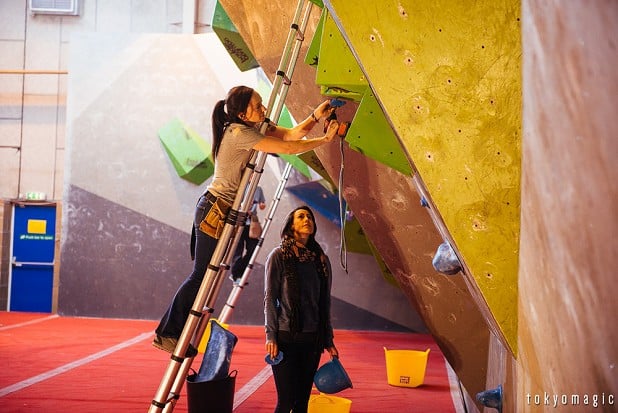

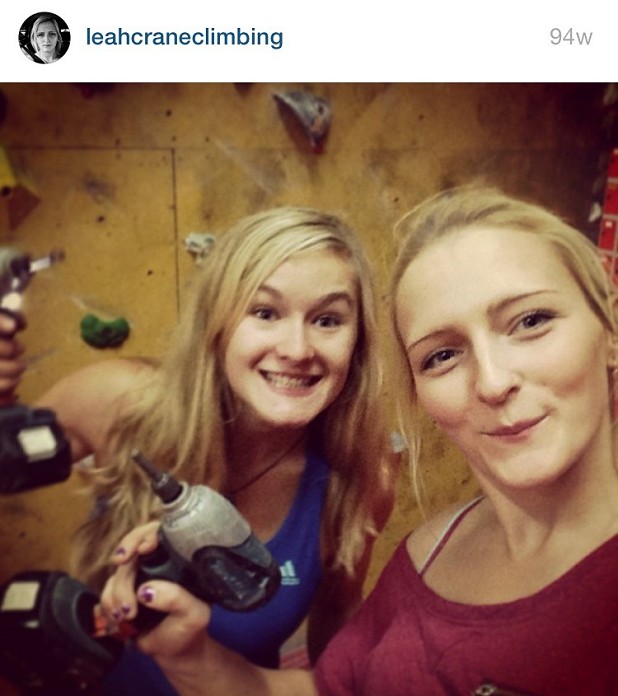
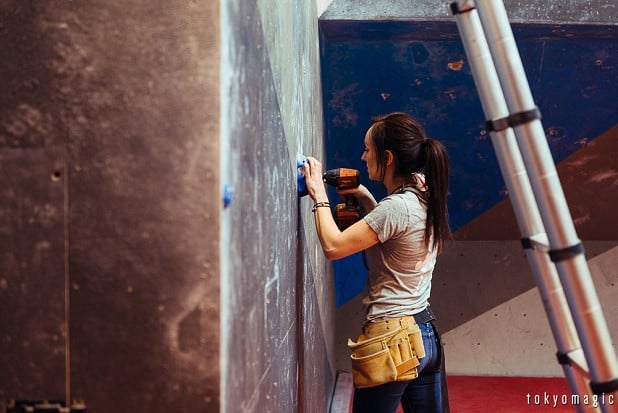





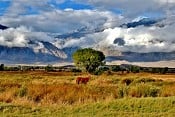






Comments